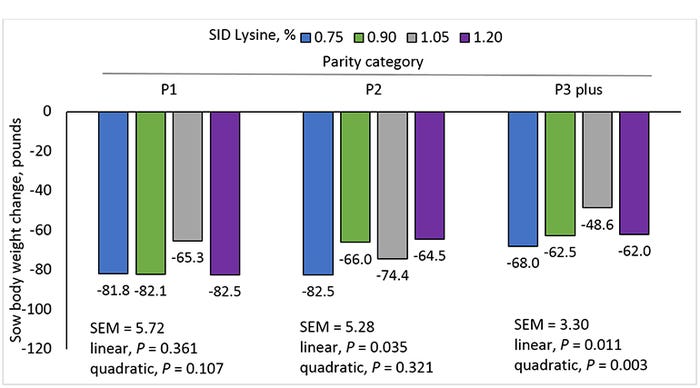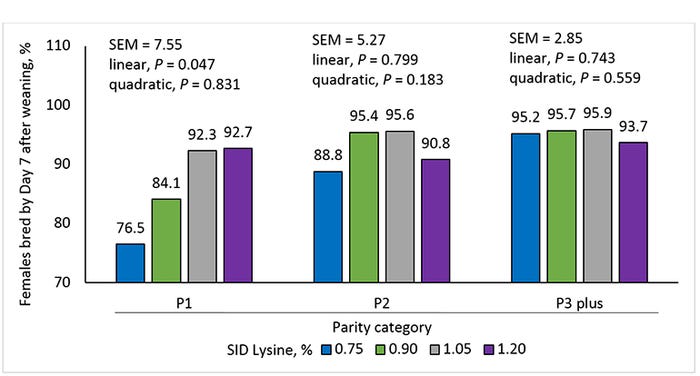Results demonstrate that the sow will mobilize body fat reserves to satisfy litter growth requirements if nutrient needs are not met by dietary intake.
March 22, 2018

By Kiah Gourley, Jason Woodworth, Joel DeRouchey, Mike Tokach and Bob Goodband, Kansas State University; Steve Kitt and Ethan Stephenson, Pillen Family Farms
In lactation, nutrients need to support both sow maintenance and piglet growth. With milk production representing about 75% of the total nutrient requirements of a lactating sow, it becomes increasingly more difficult to meet the sow’s requirements as litter size and litter growth rate increases. During the past two decades, genetic improvements have improved the efficiency and productivity of the sow herd. However, as genetics continue to evolve, requirement estimates need to be reevaluated to ensure all nutrients are met for optimum performance of the sow and her litter.
In a previous study conducted at Kansas State University, we evaluated the effect of increasing concentrations of standardized ileal digestible Lysine in lactating first parity sows. Sow backfat loss decreased as dietary SID Lysine increased from 0.80 to 1.25%, with no other differences in sow or litter performance observed. This research was conducted with a smaller sample size and did not include multiparous sows.
Thus, the current study aimed to evaluate the effect of increasing SID Lysine in lactating primiparous and multiparous sows under commercial conditions. The study was conducted at a commercial swine farm in central Nebraska with four levels of increasing SID Lysine (0.75, 0.90, 1.05 and 1.20%). A total of 710 mixed-parity sows were used in this study, with an average parity of 3.2. On Day 112 of gestation, sows were weighed, back fat and loin eye depth were measured ultrasonically, and sows were allotted to one of the four dietary treatments. Sows were moved into farrowing crates on Day 113 of gestation and began consuming experiment diets. Cross fostering occurred within 48 hours of farrowing, irrespective of treatment, in an effort to equalize litter size across treatments. Litters were weighed on Day 2 and Day 17 to capture litter growth. At weaning (ranging from Day 19 to 24), sows were weighed, and backfat and loin eye depth were measured ultrasonically. Wean-to-estrus interval, conception rate and subsequent litter performance data were also collected.

Figure 1: Estimated mean sow body weight loss from Day 112 of gestation until weaning within parity category for sows fed increasing standardized ileal digestible Lysine in lactation.
Increasing SID Lysine had no effect on sow body weight loss in gilts. However, increasing SID Lysine to 1.20% in Parity 2 sows, or 1.05% in Parity 3 or higher sows resulted in less body weight loss during lactation. Backfat loss increased as SID Lysine was increased to 1.20%, regardless of parity. Conversely, loin eye depth loss was reduced as SID Lysine was increased, with sows fed 1.20% SID Lysine gaining loin eye depth. In first parity sows, increasing SID Lysine from 0.75 to 1.05% improved the percentage of females bred by Day 7 after weaning from 76.5% to 92.3%. On the other hand, no differences were observed in post-wean reproductive characteristics for Parity 2 or higher sows.

Figure 2: Estimated percentage females bred by Day 7 after weaning within parity category for sows fed increasing standardized ileal digestible Lysine in lactation.
Litter gain from Day 2 to 17 was maximized at 1.05% SID Lysine and decreased at 1.20% SID Lysine. However, there was also a decrease in sow feed intake on the 1.20% SID Lysine treatment, which could have led to the decreased litter growth presumably because of reduced milk production. There was no difference in litter size at weaning or piglet survivability regardless of SID Lysine level in lactating sow diets.
In summary, our results demonstrate that the sow will mobilize body fat reserves to satisfy litter growth requirements if nutrient needs are not met by dietary intake. However, increasing the levels of amino acids can support the reduction of protein loss in lactation. While the optimal level of dietary SID Lysine required by the sow may vary based on response criteria and parity, it is evident that reducing protein mobilization is beneficial to reproductive performance.
You May Also Like



